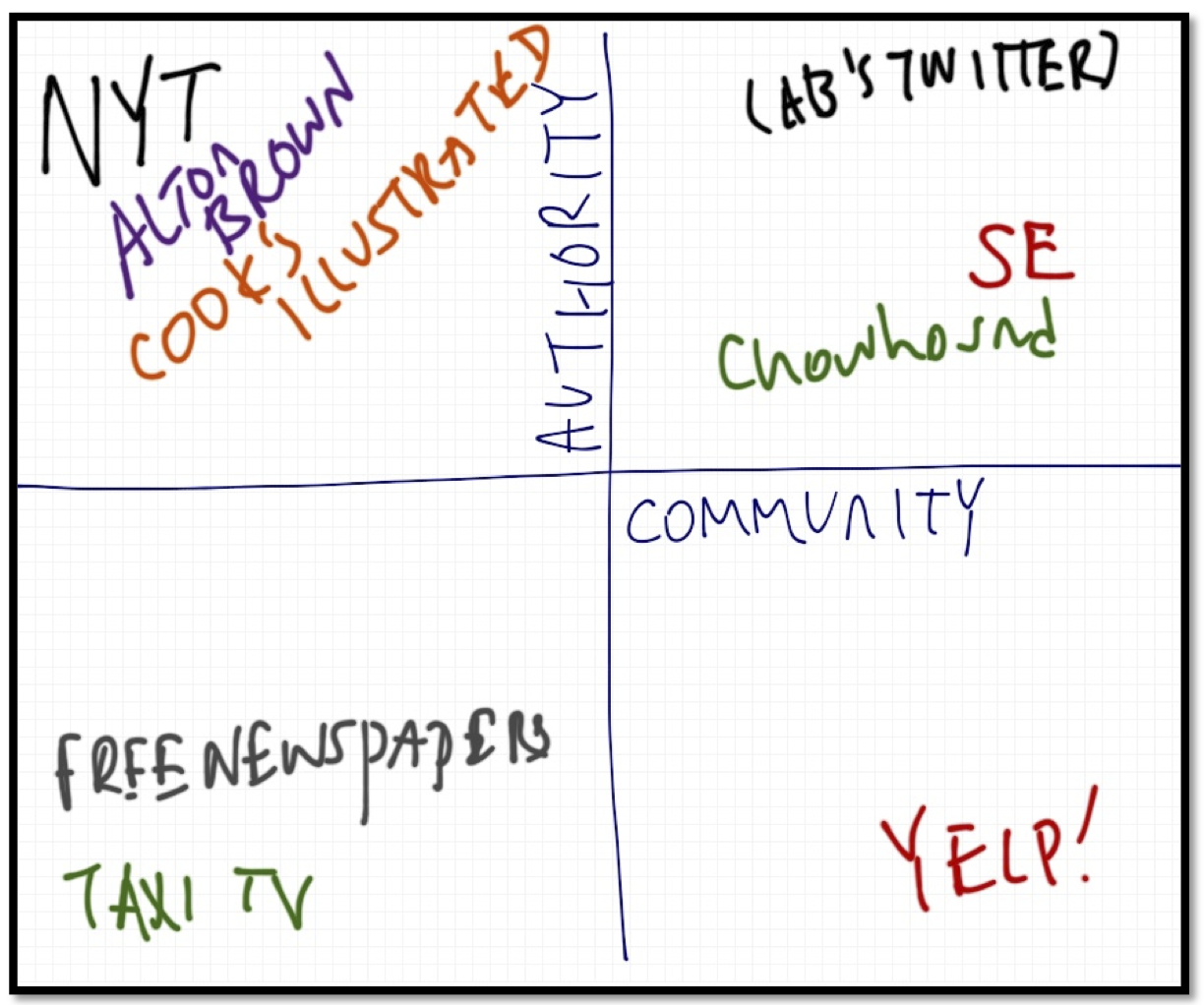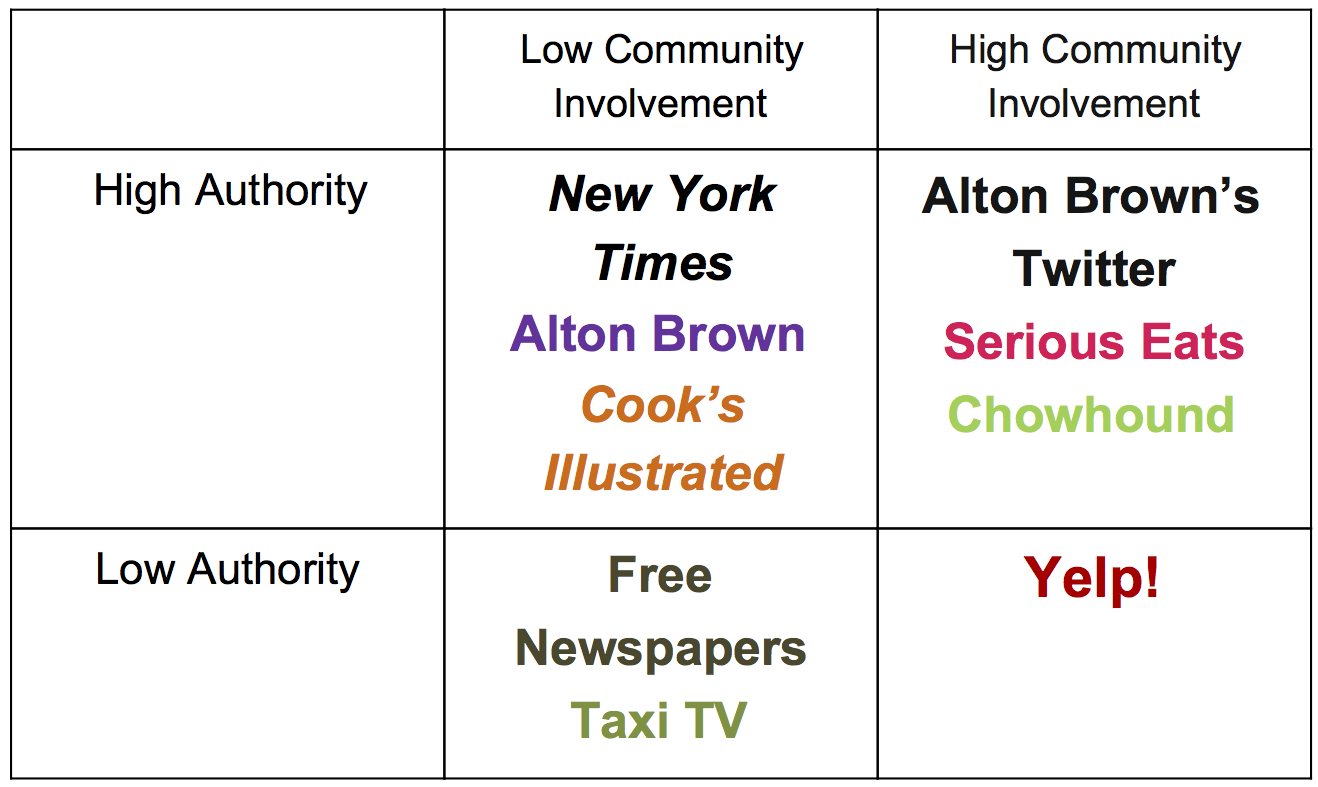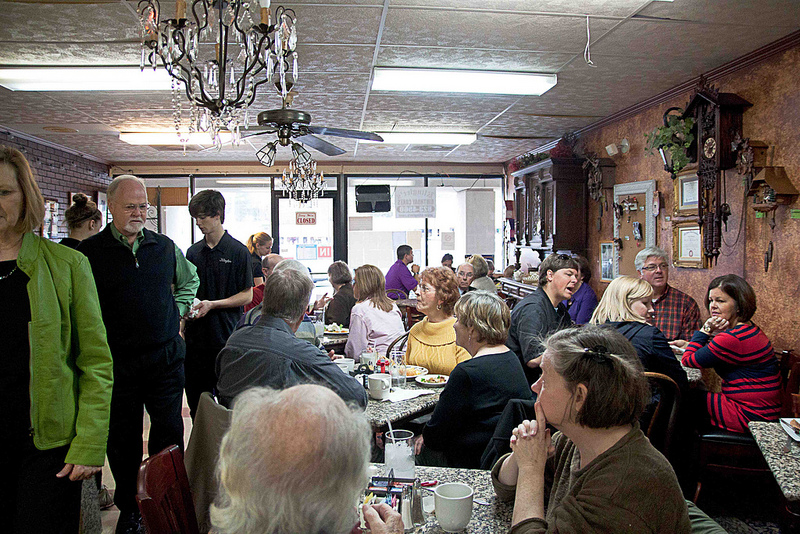loading...
Part 4 of my review of Kenji Lopez-Alt’s Talk, “I’ve Got a Test for That”: Notes from the Keynote at Food Blog South (2013) follows here. Since money often steers part of the issue in generating quality content that’s both written and published for the Internet (AND FREE), deciphering the hallmarks of good online writing may be boiled down to three mantras of quality, accessibility, and community. But, it’s just not that easy (read on). —Helana
– Architecture of a Good Blog Post –
As Kenji explains, finances will, at some point, inevitably affect the quality of one’s blog: whether you have the advertising budget of the New York Times or the low-budget, high-community resources of a website like Yelp.
If finances affect quality, then this model also holds true for levels of community:
Got little money?
Then you’re probably going to have a couple of posts that have at least a few grammatical errors or broken links. You may even leave an ingredient or two off of a recipe’s ingredients list. But, this doesn’t mean that your content is entirely bad – you may have a world of engaged readers pointing out you forgot something or asking questions and engaging you in conversation.
Got lots of money?
Well, alternatively, your recipe may be AP-worthy, tested, and perfect, but you’re most likely never going to e-mail back and forth with all of your readers. You may not even find the time or worthiness of commenting on a page at your high-profile article’s website.
In this continuum of Money vs. Community vs. Quality Content, we meet a new variable: Authority.
Kenji boils down the algebra for this publishing process ( “a + b = c” ) with the four-quadrants below:

Pictured: X-Axis = Community, Y-Axis = Authority. Kenji’s advice is that bloggers should aim to be in the the upper right-hand corner, where they possess “high authority” as well as “high levels of community involvement.”
If you find the above image a little difficult to discern – what’s “SE?” or “Taxi TV?” for example – then reference the below graph made a little more accessible to us non-science types by my intern Meredith Quinn:

Pictured: Meredith Quinn’s interpretation of Kenji’s graph. In our four quadrants, authority is stacked from highest to lowest where the top two boxes represent “high authority” and the bottom two represent “low authority”; levels of community increase from left to right and each hemisphere introduces possible variances.
Both graphs suggest ways to quantify and digest competing food writers’ experiences based on the success of their community involvement and levels of authority. Plus, they both offer two stable axes on which we can best define “success” (i.e., where “community” and “authority” meet). Do we value the high-community levels of a site like Yelp? The low-authority, guaranteed saturation of Taxi TV? Or, the high-authority measures of Alton Brown-like research with New York Times-like exclusivity?
These kinds of questions illustrate how each quadrant can be distinguished from the other, but, really, they help us to make use of what Kenji wants all Food Blog South attendees to consider:
How can we, as writers, take this information and incorporate it into our own writing? And, what is the “Anatomy of a Good Blog Post?”
Here are Kenji’s three variables:
(1) Well-Written
– Structure: stories with beginnings, middles, and ends
– Balance: content marries seriousness and light-heartedness
(2) Personal
– Passion: peak into your life to see, what makes you, “as a passonate person . . . tick”
– Authority & Trustworthiness:
Clarify what you’re sure about, and what you just don’t know.
Be honest about how much you do know and don’t pretend to know everything. (This honesty will legitimize and earn respect amongst readers.)
Essentially, Honesty = Authority & Trustworthiness
According to Kenji,
“That [structure, balance, passion, authority, & trustworthiness] really describes the best blogs.”
– Kenji Lopez-Alt
(3) Management (“Treat Blog Like a Restaurant”)
– Consistent and Regular: open on schedule; more is better, but have a set of expectations for your readers and stick to it
– Service: people come for the service and will enjoy community once there
– Community: interact with readers as much as possible—
(1) RESPOND, RESPOND, RESPOND! (Answer every single comment)
(3) Acknowledge them directly.
Example: tweet or start a conversation with readers when visiting a new place—
“What food? Drink? Dessert? Coffee? Anything? Should I try?”

Pictured: Photo taken at Klinger’s European Bakery in Birmingham, AL, the morning after Kenji’s talk. Caroline & I hit up the popular German-style eatery for crêpes, smoked sausage, and insanely rich (but expensive) chocolate cake. I think I subconsciously chose this image if only because of the outsider-looking-in experience we had as travelling food writers seeing how Birmingham locals go about their Sunday mornings for coffee and crêpes. Klinger’s is a small, family-owned restaurant, and its success probably lies in the fact that you can always order your favorite Sunday Brunch Special each weekend without fail.
“This I can’t stress hard enough. I go to some blogs, or even some of the columnists who write for my blog, and readers come in with legitimate questions, and they just sit there, ignored. It baffles my mind. It would be like if a customer walks into a restaurant, asks the server what a word means on the menu, and the server just turns and walks away.”
– Kenji Lopez-Alt
Kenji points out that forgetting to answer a reader’s comments and questions creates a hostile (albeit, perhaps unintentional and somewhat unconscious) environment in which, “You feel snubbed, and you never want to come back.”
Although it may be hard to respond to every single comment a blog entry or online article receives (especially if your writing falls into one of the higher-community and/or higher-authority quadrants above), Kenji’s points are worth mentioning nonetheless:
When you treat your website with the respect, considerateness, and authority of a good, quality restaurant, then your readers (i.e., “customers” in this analogy) have no choice but to enjoy the good service once there.
As for future or potential readers? Just like a good restaurant review on Yelp, word gets around.
For these last points, I keep thinking about what Hunter Lewis said to FBS 2013 attendees the morning of Kenji’s talk. In discussing his experiences as the new Southern Living Executive Editor, he (somewhat disappointedly) pointed out the dramatic shifts that have taken place in the ways readers respond to the magazine over the last twenty years.
During his mother’s Southern Living cookbook days (1960s-70s, I believe), readers were responsible for a huge majority of contributed recipes and letters to the editor. Today, contact between the magazine and subscribers has shifted over time, as food publishers’ continued insulation from their day-to-day readers correlates with higher levels of negative feedback.
[Note: this review trend is not unique to Southern Living, but a part of many readers’ experiences with major food pubs. today.]
Less and less do subscribers write in with positive stories about new recipes or article comments, and more and more, do they write in to complain or criticize recent publications. Hunter lamented these spikes in negative reader feedback over the years (not just for his magazine, but for food publishers and magazines in general).

Pictured: pages from a not-so-old copy of a Southern Living Christmas Issue with recipes like the ones Hunter Lewis discussed in his FBS 2013 talk.
By increasing our sense of community with readers—whether it’s a blog, newspaper, or magazine like Southern Living—good things can happen, and an essential ingredient is in place for “good blog post anatomy.”
[More on this last point and Hunter Lewis in my upcoming article on Southern Living.]
My point is this: cultural and publication shifts indicate exactly what Kenji finds so important in reader comments on a blog like Serious Eats: we must engage and connect with our readers; otherwise, we run the risk of coming off as unreachable, disconnected disseminators of information who thoughtlessly share knowledge without considering who or what readers might find when they engage with our content.
Kenji’s “Anatomy of a Good Blog Post” articulates necessary philosophies about food writing: a truly good blog post is like a living thing, and we continue to doctor and understand its effectiveness when we take the time to examine our own levels of community and authority the same way a doctor might with a patient’s capillaries and bones. . . .
[In the words of my intern, Meredith Quinn, “You don’t want to have this conversation with English majors! We can dissect anything, especially imagery!”]
—
For Kenji’s final words of wisdom, Serious Eats examples, and advice, checkout tomorrow’s installment, Part 5: “What Crazy thing Can I Do?” from his talk, “I’ve Got a Test for That”: Notes from the Keynote, to Food Blog South attendees this past January 2013.
Directory:
Or, See Part 1: “I’ve Got a Test for That”
Part 3: “The Good, the Bag, & the Plain Weird”
Part 4: “The Architecture of a Good Blog Post” (above)
Part 5: “What Crazy thing Can I Do?”
—
Follow me on Pinterest: http://pinterest.com/helana/
Twitter: https://twitter.com/DancesWLobsters
Facebook: https://www.facebook.com/pages/Clearly-Delicious/103136413059101
Tumblr: http://clearlydelicious.tumblr.com/
Instagram: http://instagram.com/helanabrigman
Part 4: "The Architecture of a Good Blog Post," Kenji Lopez-Alt of Serious Eats,

No Comments